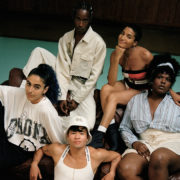The Producer’s Voice: Manon Dave [@manondave]
![The Producer’s Voice: Manon Dave [@manondave]](https://guap.co/wp-content/uploads/2021/07/pasted-image-0-2-180x180.jpeg)
Words By Miki Hellerbach
The Producer’s Voice is a new series for GUAP where we highlight the stories of instrumental crafters. We hope to bring their stories to the forefront instead of kept behind the artist they are producing for.
North London raised producer, engineer, and creative technologist Manon Dave has of the most wide ranging careers we’ve covered in the column thus far.
Raised by parents from India, Dave took in the sounds of Classical Indian and Bollywood music in his upbringing as well as whatever was on Top of the Pops. When he was 15 he got one of the original versions of FL Studio on a home computer which sparked his lifelong production interest. His passion was truly ignited at University when he saw others diving headfirst in music while pursuing other degrees.
While studying Software Engineering, Dave made connections on Myspace with other artists to produce for. When he connected with UK rapper Messiahbolical he garnered his first solid indy placements. Dave‘s indy work eventually led to him getting his first major label placement in 2008 which had him working on a track that was for Japanese special release.
This all eventually led to Dave linking with legendary composer AR Rahman before he composed the Oscar winning score for the film Slumgdog Millionaire. Rahman introduced him to soul singer PJ Morton, which led to Dave co-producing Morton’s 2013 single “Heavy” featuring Maroon 5’s Adam Levine. Dave has gone on to produce for various artists including executive producing Che Lingo’s epic 2020 album The Worst Generation, which has led to his current publishing deal with 7Wallace and Universal Music.
In addition to his music production, Dave also has fused his software knowledge into his work. He helped develop the Maschine Mk2 for the company Native Instruments as their project manager and also helped create the Roli Seaboard Piano Keyboard. These two products are now both sold and used by top tier producers worldwide.

I asked Manon Dave to give the backstory of three of his top instrumentals. Take a read.
“Dark Days” by Che Lingo feat. Kojey Radical
“It was a full circle moment. Che had brought me the stems from a producer called D’Artizt, which was just a bunch of loops with his and eventually Kojey’s vocals. The rest of the album needed a sort of bridge song. Something to stitch the more introspective with the Drill or upbeat UK Hip Hop.
I did a mix pass on the stems and got into the pockets of matching Che’s flow with the drum patterns and the breaks with the silences that fill the space. [I tried to achieve] a J Dilla, Kanye, or Timbaland thing where the beat is rapping to you. They have these parallel cadences between percussion and the sample if they use one. I tried to approach this in the same way, rebuilding from the ground up what was great about the original demo with something that matched both their flows from a percussion and mix perspective.
The harp is so iconic on it and to match it emotively with something else we went full in. That’s where the string section comes from. We ended up using musicians from the sunshine orchestra from AR Rahman’s KM Music Conservatory he built in India. It was a huge moment. When I brought those string parts in for the final session with Che he said, “Bro I literally can’t believe this is my song.” It’s all about capturing the artist’s best version of their story.”
“My Block” by Che Lingo
“All credit here goes to Tony Bones, the main producer. This one was more boxed and ready to ship and I put the bow on it. My job was taking the mix and mastering component and really elevating everything that was already there. I took the essence and made it feel mixing wise a lot closer to “Dark Days”, which became the benchmark for the polish that was on it. It elevated everything. Initially, the mix was really narrow, like if you played it at a block party it would hit, but if you were to play it at a high end studio, on headphones, or in your car it wouldn’t translate the same way.
I had to open Che’s eyes to there being a way to make it knock, but also get it to play against your favorite Pop artist on the radio. I did that by going deep on the width of the track as well as his vocal chain by EQing his voice to bring out his rich mid-tone. A bit of a full circle moment because Tony Bones is an exclusive Native Instruments Maschine producer. For me I felt like a proud Dad because it was built on something I created.”
“Mind” by Lois Rae feat. Wynts
“I really love this beat because one of the first records I heard was Timbaland’s, Tim’s Bio: Life from da Bassment. In 1999 I heard that record on a trip to the states in a Sam Goody. When I went down the rabbit hole of that sound I found the drums to be like percussive acrobatics. He was doing crazy shit that he didn’t need to do, but it sounded so dope and surprising. There was a swing, but unnecessary extra percussion that would come out of nowhere and kick you in the teeth. I always wanted to produce like that but put my own signature on it.
This beat feels like me because it’s soulful, but (it also) punches in the same way as some of those Timbaland songs. When I played Lois this beat it was after I’d taken it to a few sessions where people didn’t know how to find the pocket, especially rappers. But she fucked with it and we wrote the song with my friend Sophie-Rose Goldsworthy. Then I told her don’t put anything in the post-chorus cuz I’m gonna chop up your vocals and it’s gonna sound crazy. That (inspiration) came from the whole Soulection wave in LA. I combined that with the Timbo slap on the drums. Vibey and wavy at the same time.”
Follow Manon Dave on Instagram and Twitter for any and all updates.





![ZINO VINCI’S ‘FILTHY & DISGUSTING’EP BRINGS YOU TO THE CORE OF THE ARTIST [@ZinoVinci]](https://guap.co/wp-content/uploads/2023/10/Zino-4.jpg)




